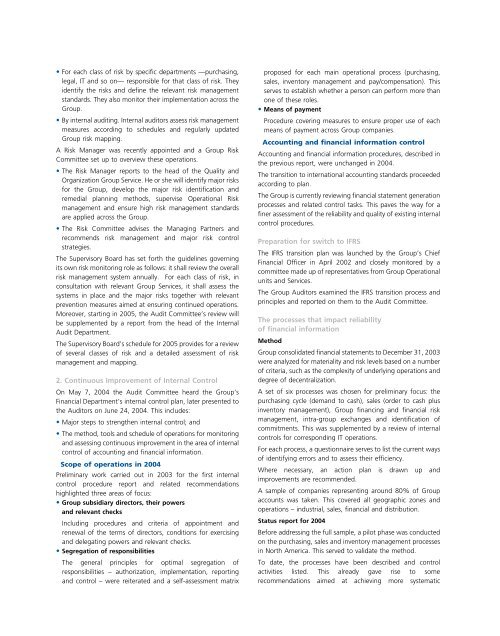Michelin couv courteGB
Michelin couv courteGB
Michelin couv courteGB
Create successful ePaper yourself
Turn your PDF publications into a flip-book with our unique Google optimized e-Paper software.
• For each class of risk by specific departments —purchasing,<br />
legal, IT and so on— responsible for that class of risk. They<br />
identify the risks and define the relevant risk management<br />
standards. They also monitor their implementation across the<br />
Group.<br />
• By internal auditing. Internal auditors assess risk management<br />
measures according to schedules and regularly updated<br />
Group risk mapping.<br />
A Risk Manager was recently appointed and a Group Risk<br />
Committee set up to overview these operations.<br />
• The Risk Manager reports to the head of the Quality and<br />
Organization Group Service. He or she will identify major risks<br />
for the Group, develop the major risk identification and<br />
remedial planning methods, supervise Operational Risk<br />
management and ensure high risk management standards<br />
are applied across the Group.<br />
• The Risk Committee advises the Managing Partners and<br />
recommends risk management and major risk control<br />
strategies.<br />
The Supervisory Board has set forth the guidelines governing<br />
its own risk monitoring role as follows: it shall review the overall<br />
risk management system annually. For each class of risk, in<br />
consultation with relevant Group Services, it shall assess the<br />
systems in place and the major risks together with relevant<br />
prevention measures aimed at ensuring continued operations.<br />
Moreover, starting in 2005, the Audit Committee’s review will<br />
be supplemented by a report from the head of the Internal<br />
Audit Department.<br />
The Supervisory Board’s schedule for 2005 provides for a review<br />
of several classes of risk and a detailed assessment of risk<br />
management and mapping.<br />
2. Continuous Improvement of Internal Control<br />
On May 7, 2004 the Audit Committee heard the Group’s<br />
Financial Department’s internal control plan, later presented to<br />
the Auditors on June 24, 2004. This includes:<br />
• Major steps to strengthen internal control; and<br />
• The method, tools and schedule of operations for monitoring<br />
and assessing continuous improvement in the area of internal<br />
control of accounting and financial information.<br />
Scope of operations in 2004<br />
Preliminary work carried out in 2003 for the first internal<br />
control procedure report and related recommendations<br />
highlighted three areas of focus:<br />
• Group subsidiary directors, their powers<br />
and relevant checks<br />
Including procedures and criteria of appointment and<br />
renewal of the terms of directors, conditions for exercising<br />
and delegating powers and relevant checks.<br />
• Segregation of responsibilities<br />
The general principles for optimal segregation of<br />
responsibilities – authorization, implementation, reporting<br />
and control – were reiterated and a self-assessment matrix<br />
proposed for each main operational process (purchasing,<br />
sales, inventory management and pay/compensation). This<br />
serves to establish whether a person can perform more than<br />
one of these roles.<br />
• Means of payment<br />
Procedure covering measures to ensure proper use of each<br />
means of payment across Group companies.<br />
Accounting and financial information control<br />
Accounting and financial information procedures, described in<br />
the previous report, were unchanged in 2004.<br />
The transition to international accounting standards proceeded<br />
according to plan.<br />
The Group is currently reviewing financial statement generation<br />
processes and related control tasks. This paves the way for a<br />
finer assessment of the reliability and quality of existing internal<br />
control procedures.<br />
Preparation for switch to IFRS<br />
The IFRS transition plan was launched by the Group’s Chief<br />
Financial Officer in April 2002 and closely monitored by a<br />
committee made up of representatives from Group Operational<br />
units and Services.<br />
The Group Auditors examined the IFRS transition process and<br />
principles and reported on them to the Audit Committee.<br />
The processes that impact reliability<br />
of financial information<br />
Method<br />
Group consolidated financial statements to December 31, 2003<br />
were analyzed for materiality and risk levels based on a number<br />
of criteria, such as the complexity of underlying operations and<br />
degree of decentralization.<br />
A set of six processes was chosen for preliminary focus: the<br />
purchasing cycle (demand to cash), sales (order to cash plus<br />
inventory management), Group financing and financial risk<br />
management, intra-group exchanges and identification of<br />
commitments. This was supplemented by a review of internal<br />
controls for corresponding IT operations.<br />
For each process, a questionnaire serves to list the current ways<br />
of identifying errors and to assess their efficiency.<br />
Where necessary, an action plan is drawn up and<br />
improvements are recommended.<br />
A sample of companies representing around 80% of Group<br />
accounts was taken. This covered all geographic zones and<br />
operations – industrial, sales, financial and distribution.<br />
Status report for 2004<br />
Before addressing the full sample, a pilot phase was conducted<br />
on the purchasing, sales and inventory management processes<br />
in North America. This served to validate the method.<br />
To date, the processes have been described and control<br />
activities listed. This already gave rise to some<br />
recommendations aimed at achieving more systematic


